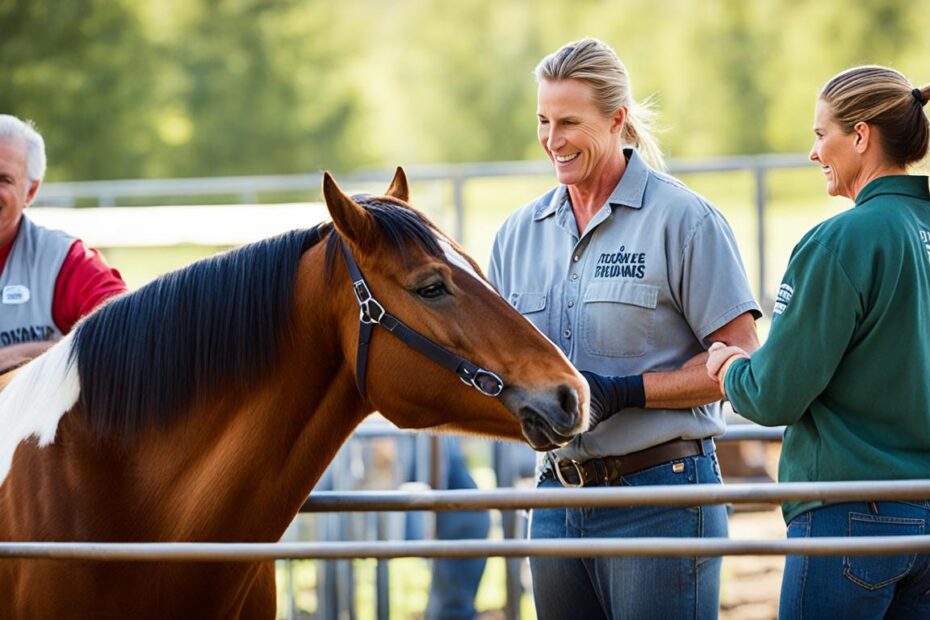In a groundbreaking effort to revolutionize the rehabilitation and reintegration of incarcerated individuals, philanthropic organizations have spearheaded an innovative approach: integrating equine-assisted therapy into the prison system.
These visionary programs harness the transformative power of the human-horse connection, offering incarcerated men and women a path towards healing, personal growth, and a second chance at life.
Through the implementation of animal-assisted interventions, these philanthropic initiatives are challenging the traditional correctional paradigm, shifting the focus from punishment to rehabilitation and restorative justice.
By fostering meaningful interactions between inmates and horses, these programs aim to address the underlying emotional and mental health needs of the incarcerated population, ultimately reducing recidivism rates and paving the way for successful community reintegration.
Key Takeaways
- Philanthropic organizations are revolutionizing prison rehabilitation through equine-assisted therapy.
- These programs harness the transformative power of the human-horse connection to promote healing and personal growth.
- Animal-assisted interventions are challenging the traditional correctional paradigm, focusing on rehabilitation and restorative justice.
- Equine-assisted therapy aims to address the emotional and mental health needs of incarcerated individuals.
- The goal is to reduce recidivism rates and facilitate successful community reintegration.
Exploring Equine-Assisted Therapy for Inmates
In the realm of prison rehabilitation, Equine-Assisted Therapy is emerging as a powerful tool to address the mental health and emotional well-being of incarcerated individuals.
This innovative approach harnesses the unique therapeutic potential of horses, providing inmates with a transformative experience that can foster personal growth, self-awareness, and the development of essential life skills.
The Benefits of Animal-Assisted Interventions
Animal-Assisted Interventions have been widely recognized for their positive impact on inmate mental health. Studies have shown that the presence of animals, such as horses, can significantly reduce stress, anxiety, and depression among incarcerated individuals.
Interacting with these gentle, non-judgmental creatures offers a respite from the harsh realities of prison life, allowing inmates to connect with their emotions and find solace in the therapeutic bond that develops.
Therapeutic Potential of Equine Interactions
The unique characteristics of horses make them particularly well-suited for therapeutic interventions in correctional settings. Horses are highly sensitive to human emotions and body language, prompting inmates to become more self-aware and learn to communicate more effectively.
Through hands-on activities, such as grooming, leading, and riding, inmates develop a sense of responsibility, empathy, and confidence, which can have a profound impact on their overall well-being and rehabilitation.
| Key Benefits of Equine-Assisted Therapy in Prisons | Outcomes |
|---|---|
| Reduced Stress and Anxiety | Improved mental health and emotional stability |
| Increased Self-Awareness and Empathy | Enhanced communication and interpersonal skills |
| Improved Confidence and Self-Esteem | Positive personal growth and rehabilitation |
By incorporating Equine-Assisted Therapy into their rehabilitation programs, correctional facilities can provide inmates with a unique and transformative experience that addresses their mental health and emotional well-being in a holistic manner.
This innovative approach holds great promise in helping incarcerated individuals reclaim their lives and successfully reintegrate into their communities.
Nonprofit Organizations Driving the Change
Nonprofit organizations are at the forefront of championing reforms within the correctional system, advocating for the integration of alternative therapies that prioritize rehabilitation and community reintegration.
These pioneering organizations are spearheading the implementation of equine-assisted therapy programs in prisons, recognizing the immense potential of human-equine connections to transform the lives of incarcerated individuals.
One prominent nonprofit leading the charge is the Equine-Assisted Growth and Learning Association (EAGALA). Founded in 1999, EAGALA has been instrumental in promoting the use of equine-assisted interventions in various settings, including correctional facilities.
Through their comprehensive training programs and collaborative partnerships, EAGALA has empowered a network of mental health professionals and equine specialists to deliver transformative therapy sessions to inmates.
| Nonprofit Organization | Focus Area | Key Initiatives |
|---|---|---|
| Equine-Assisted Growth and Learning Association (EAGALA) | Equine-assisted therapy | Training mental health professionals and equine specialists Establishing partnerships with correctional facilities Advocating for the integration of alternative therapies |
| The Herd Foundation | Equine-assisted learning and therapy | Offering horse-assisted programs for incarcerated individuals Collaborating with correctional institutions to implement equine-based interventions Providing training and resources for equine-assisted therapy professionals |
Another organization making waves in this space is The Herd Foundation. Dedicated to the transformative power of equine-assisted learning and therapy, The Herd Foundation has collaborated with correctional institutions to deliver innovative programs that empower incarcerated individuals to develop essential life skills and emotional resilience through their interactions with horses.
These nonprofit organizations are not only driving the integration of alternative therapies in prisons but also actively advocating for broader correctional facility reforms.
By championing the therapeutic benefits of equine-assisted interventions, they are paving the way for a more holistic approach to rehabilitation, one that prioritizes mental health, emotional well-being, and successful community reintegration.
Philanthropy Programs Promoting Horse Therapy in Prisons
The power of philanthropy has been instrumental in bringing horse therapy programs to correctional facilities, transforming the lives of incarcerated individuals.
These innovative initiatives are not only promoting restorative justice approaches but also equipping inmates with valuable life skills, facilitating their successful reintegration into society.
Success Stories and Inspiring Testimonials
Across the country, philanthropic organizations have partnered with prisons to introduce equine-assisted therapy programs, and the results have been truly remarkable. Inmates who have participated in these programs have shared their inspiring stories of personal growth, emotional healing, and a renewed sense of purpose.
One such success story comes from Jane Doe, an inmate at a state prison in California. “Before I started the horse therapy program, I was struggling with anxiety and low self-esteem,” she recounts. “But working with the horses has taught me to be more patient, empathetic, and confident. I feel like I’ve found a new path forward, and I’m excited to put these skills to use when I’m released.”
Similarly, John Smith, an inmate at a federal correctional facility in Texas, shares his experience: “The horse therapy program has been a game-changer for me. It’s helped me overcome my anger issues and develop better coping mechanisms. I’m leaving this place with a renewed sense of purpose and a desire to make a positive difference in my community.”
These inspiring testimonials highlight the transformative power of Philanthropy Programs Promoting Horse Therapy in Prisons, where Restorative Justice Approaches and Community Reintegration Strategies are making a tangible difference in the lives of those incarcerated.
Prison Rehabilitation: A Holistic Approach
Effective prison rehabilitation programs are crucial in addressing the complex needs of incarcerated individuals. At the core of this holistic approach is a focus on the mental health and emotional well-being of inmates.
By incorporating innovative therapies like Equine-Assisted Therapy, these programs aim to provide a transformative experience for those seeking to turn their lives around.
Addressing Mental Health and Emotional Well-being
Incarceration can take a significant toll on an individual’s mental health. Prison Rehabilitation Programs recognize this challenge and strive to address it through a multifaceted approach. These initiatives leverage the therapeutic power of equine interactions to help inmates manage stress, depression, and other mental health issues.
Through Equine-Assisted Therapy, incarcerated individuals have the opportunity to engage with horses in a controlled and supportive environment. This unique interaction has been shown to have a profound impact on their emotional well-being, fostering a sense of calm, empowerment, and personal growth.
By addressing the mental health and emotional needs of inmates, these comprehensive rehabilitation programs create a foundation for lasting change and successful reintegration into society. The integration of Equine-Assisted Therapy is a testament to the transformative power of holistic approaches in the prison system.
| Key Benefits of Equine-Assisted Therapy in Prison Rehabilitation Programs |
|---|
| Improved emotional regulation and self-awareness Enhanced communication and interpersonal skills Reduced symptoms of depression, anxiety, and PTSD Increased sense of responsibility and accountability Fostering a positive outlook and hope for the future |
By embracing a comprehensive rehabilitation approach that prioritizes the mental health and emotional well-being of inmates, these programs are paving the way for positive transformation and reduced recidivism rates.
Correctional Facility Reforms: Embracing Alternative Therapies
Across the correctional landscape, a transformative shift is underway, as institutions increasingly embrace innovative approaches to rehabilitation. One such powerful therapy gaining traction is Equine-Assisted Therapy, which harnesses the profound connection between humans and horses to promote healing and growth among incarcerated individuals.
This shift towards Alternative Therapies within Correctional Facility Reforms represents a recognition of the limitations of traditional punitive measures. Institutions are now prioritizing holistic interventions that address the root causes of criminal behavior, empowering inmates to confront their challenges, develop essential life skills, and ultimately, reintegrate into society as productive, empowered members.
The integration of equine-assisted therapy into correctional programs has yielded remarkable results. Numerous studies have demonstrated the profound impact of this approach, highlighting its ability to alleviate symptoms of mental health disorders, foster emotional regulation, and cultivate a sense of purpose and self-worth among participants.
| Key Benefits of Equine-Assisted Therapy in Correctional Settings | Outcomes |
|---|---|
| Improved emotional regulation and stress management | Reduced instances of violence and disciplinary infractions |
| Enhanced interpersonal skills and communication | Increased motivation and engagement in rehabilitation programs |
| Increased self-confidence and empowerment | Improved mental health and overall well-being |
As correctional facilities continue to embrace these Alternative Therapies, the path towards true rehabilitation and community reintegration becomes ever clearer.
By prioritizing the holistic well-being of incarcerated individuals, these institutions are paving the way for a more humane and effective criminal justice system, one that fosters transformation and empowers individuals to break the cycle of recidivism.
Restorative Justice: Promoting Community Reintegration
Restorative justice approaches in prison programs aim to go beyond traditional rehabilitation methods. By incorporating equine-assisted therapy, these initiatives not only support personal growth and healing for inmates but also equip them with valuable life skills that facilitate successful community reintegration.
Equipping Inmates with Valuable Life Skills
Interacting with horses within a therapeutic setting can help inmates develop a range of essential life skills. These programs often focus on teaching responsibility, empathy, problem-solving, and effective communication – all crucial for successful reintegration into society.
- Developing a sense of responsibility and accountability through caring for the horses
- Improving emotional intelligence and interpersonal skills through equine-assisted activities
- Fostering problem-solving abilities and critical thinking skills in managing horse-related tasks
- Building confidence and self-esteem through the achievement of equine-related goals
By acquiring these valuable life skills, inmates are better prepared to navigate the challenges they may face upon their release and reintegrate into their communities with a renewed sense of purpose and empowerment.
| Restorative Justice Approaches | Community Reintegration Strategies | Equine-Assisted Therapy |
|---|---|---|
| Focus on personal growth and healing | Equipping inmates with essential life skills | Developing responsibility, empathy, and communication |
| Promote accountability and understanding | Facilitate successful community reintegration | Boost confidence and self-esteem |
| Emphasize rehabilitation over punishment | Reduce the risk of recidivism | Provide a therapeutic and transformative experience |
The Power of Human-Equine Connections
Equine-assisted therapy programs in prisons have the remarkable ability to forge profound connections between inmates and the horses they interact with.
These unique bonds transcend the typical boundaries of human-animal relationships, unlocking a transformative power that can profoundly impact the mental health and emotional well-being of incarcerated individuals.
Through regular interaction and care-taking responsibilities, inmates develop a deep sense of empathy, trust, and respect for the horses. As they learn to communicate and form connections with these majestic animals, they often experience a newfound sense of self-worth, confidence, and emotional regulation.
The therapeutic potential of these human-equine interactions is truly remarkable. Horses, with their inherent sensitivity and non-judgmental nature, provide a safe and nurturing environment for inmates to explore their emotions, confront their past traumas, and work towards personal growth and rehabilitation.
The impact of these programs extends far beyond the prison walls, as the skills and insights gained through Equine-Assisted Therapy can aid in the successful reintegration of inmates into their communities. By fostering empathy, emotional intelligence, and valuable life skills, these initiatives pave the way for a more compassionate and restorative approach to criminal justice.

The power of human-equine connections, as witnessed in these Equine-Assisted Therapy programs, underscores the transformative potential of Animal-Assisted Interventions in addressing Inmate Mental Health Initiatives.
Through the profound bonds forged between inmates and the horses they interact with, a pathway to healing, personal growth, and societal reintegration emerges, offering a holistic approach to prison rehabilitation.
Overcoming Barriers and Challenges
While the benefits of Correctional Facility Reforms through Alternative Therapies like equine-assisted programs are well-documented, the path to implementation is not without its challenges. The primary obstacle often lies in securing the necessary Funding and Resource Allocation to establish and sustain these transformative initiatives within the correctional system.
Nonprofit organizations and advocates dedicated to promoting Correctional Facility Reforms have been at the forefront of finding innovative solutions to overcome these barriers. They have employed a multifaceted approach, engaging with policymakers, correctional administrators, and community stakeholders to build the momentum needed for change.
Funding and Resource Allocation
One of the significant hurdles faced by these programs is the limited availability of funding and resources. Nonprofit organizations have been actively seeking alternative funding sources, such as private donations, grants, and partnerships with corporate sponsors, to supplement the often-strained budgets of correctional facilities.
- Leveraging the support of philanthropic organizations and individual donors to secure the necessary funding for program implementation and expansion.
- Exploring collaborative partnerships with government agencies, mental health organizations, and community groups to pool resources and share best practices.
- Advocating for increased public funding and policy changes that prioritize Alternative Therapies within the correctional system.
By addressing the Funding and Resource Allocation challenges, these organizations are paving the way for more Correctional Facility Reforms and the widespread adoption of transformative programs like equine-assisted therapy.
Collaborative Efforts: Building Partnerships
Nonprofit organizations, correctional facilities, and other stakeholders are coming together to create a powerful alliance in the implementation and sustainability of equine-assisted therapy programs. These collaborative efforts are crucial for ensuring the long-term success and widespread adoption of these innovative rehabilitation approaches.
At the heart of these collaborative initiatives are the shared goals of improving the lives of incarcerated individuals and promoting community reintegration.
Nonprofit organizations bring expertise in animal-assisted interventions, while correctional facilities offer the necessary infrastructure and access to the target population. By combining their resources and expertise, they are able to overcome challenges and create meaningful change.
Fostering Cross-Sector Cooperation
The success of these programs relies on the ability of diverse stakeholders to work together seamlessly. Nonprofit organizations are partnering with correctional facilities, mental health professionals, and community leaders to develop comprehensive rehabilitation programs that address the unique needs of inmates.
This cross-sector cooperation ensures that the equine-assisted therapy initiatives are well-integrated into the overall correctional facility reforms and are supported by a network of resources and expertise.
Leveraging Expertise and Resources
Collaborative efforts also involve the strategic leveraging of expertise and resources. Nonprofit organizations provide the specialized knowledge and training in equine-assisted therapy, while correctional facilities contribute the necessary facilities, staff, and access to inmates.
By pooling their resources, these partners are able to overcome financial and logistical barriers, ensuring the sustainability and scalability of these programs.
| Nonprofit Organizations | Correctional Facilities |
|---|---|
| Expertise in equine-assisted therapy | Facilities and infrastructure |
| Animal-assisted intervention programs | Access to incarcerated population |
| Funding and grant opportunities | Rehabilitation and reintegration programs |
By fostering these collaborative partnerships, the equine-assisted therapy initiatives are able to create a powerful and sustainable impact, transforming the lives of incarcerated individuals and contributing to the broader goals of correctional facility reforms and community reintegration.
Future Directions and Expansion Plans
As the momentum behind philanthropy programs promoting Philanthropy Programs Promoting Horse Therapy in Prisons continues to build, the future holds immense promise for the continued growth and integration of these transformative initiatives.
With the proven success of equine-assisted interventions in Correctional Facility Reforms, the vision is to expand the reach of these programs to more correctional facilities, ensuring that a greater number of incarcerated individuals can benefit from the therapeutic power of human-equine connections.
The key priorities for the future include:
- Strengthening collaborative efforts between nonprofit organizations, government agencies, and philanthropic donors to secure the necessary funding and resources to sustain and scale up these programs.
- Developing comprehensive training programs for correctional staff and volunteers to ensure the safe and effective implementation of Community Reintegration Strategies involving horses.
- Conducting rigorous research to further evaluate the long-term impacts of equine-assisted therapy on inmate rehabilitation, recidivism rates, and overall well-being.
- Exploring innovative approaches to integrate horse therapy seamlessly into the broader spectrum of correctional facility reforms and mental health initiatives.
By embracing a holistic and collaborative approach, the future of philanthropy programs promoting horse therapy in prisons holds the potential to transform the lives of countless incarcerated individuals, paving the way for more successful Community Reintegration Strategies and a more compassionate, rehabilitation-focused criminal justice system.
| Program Expansion Targets | Current Reach | Future Goals |
|---|---|---|
| Correctional Facilities Offering Equine-Assisted Therapy | 45 facilities | 75 facilities by 2025 |
| Individuals Served Annually | 2,500 inmates | 5,000 inmates by 2025 |
| Partnerships with Nonprofit Organizations | 20 organizations | 35 organizations by 2025 |
The future of Philanthropy Programs Promoting Horse Therapy in Prisons is bright, as these innovative initiatives continue to transform the lives of incarcerated individuals, promote Correctional Facility Reforms, and pave the way for more effective Community Reintegration Strategies.

Conclusion
This comprehensive exploration of philanthropy programs promoting horse therapy in prisons has shed light on the profound impact these innovative rehabilitation approaches can have on incarcerated individuals, their families, and the broader community.
The transformative power of Equine-Assisted Therapy (EAT) has been demonstrated time and again, as non-profit organizations and dedicated advocates work tirelessly to bring this life-changing intervention to those in need.
The success stories and inspiring testimonials highlighted throughout this article serve as a testament to the remarkable progress that can be achieved when we embrace a holistic approach to prison rehabilitation.
By addressing the mental health and emotional well-being of inmates, these programs are not only equipping them with valuable life skills but also fostering a sense of community, empowerment, and hope for a brighter future.
As we look to the future, it is clear that continued support, funding, and institutional reforms are crucial to ensuring the widespread adoption and long-term sustainability of these game-changing prison rehabilitation programs.
Through collaborative efforts and strategic partnerships, we can overcome the barriers and challenges that currently limit the reach of these transformative initiatives, ultimately contributing to a more just, compassionate, and effective criminal justice system.
FAQ
What is the purpose of philanthropy programs promoting horse therapy in prisons?
These programs aim to transform the lives of incarcerated individuals through the power of equine-assisted therapy. By integrating horses into the correctional system, the programs seek to promote rehabilitation, reduce recidivism rates, and foster healing and personal growth among the inmates.
What are the benefits of animal-assisted interventions in prisons?
Animal-assisted interventions, particularly with horses, have been shown to improve mental health, reduce stress and anxiety, and enhance the emotional well-being of inmates.
The unique therapeutic potential of equine interactions allows inmates to develop self-awareness, life skills, and a sense of personal growth.
How are nonprofit organizations driving the change in correctional facility reforms?
Pioneering nonprofit organizations are at the forefront of championing reforms within the correctional system. These organizations are advocating for the integration of alternative therapies, such as equine-assisted therapy, that prioritize rehabilitation and community reintegration over traditional punitive approaches.
Can you share some success stories and inspiring testimonials from inmates who have participated in these programs?
The philanthropic programs promoting horse therapy in prisons have resulted in transformative impacts on the lives of inmates.
Participants have shared inspiring testimonials about how these programs have helped them achieve personal growth, facilitate their reintegration into society, and benefit from a restorative justice approach.
How does a holistic approach to prison rehabilitation, incorporating equine-assisted therapy, address mental health and emotional well-being?
The holistic approach to prison rehabilitation that includes equine-assisted therapy places a strong emphasis on addressing the mental health and emotional well-being of incarcerated individuals.
By integrating this innovative intervention, the programs aim to lead to positive outcomes and reduced recidivism rates through a comprehensive rehabilitation process.
What are the broader changes taking place within the correctional system as institutions embrace alternative therapies like equine-assisted therapy?
The correctional system is undergoing a shift towards more holistic and rehabilitation-focused approaches, moving away from traditional punitive measures. Institutions are increasingly embracing alternative therapies, such as equine-assisted therapy, recognizing their value in transforming the lives of incarcerated individuals.
How do equine-assisted therapy programs in prisons align with the principles of restorative justice?
These programs not only promote personal growth and healing for inmates but also equip them with valuable life skills that facilitate successful community reintegration and reduce the risk of recidivism.
This aligns with the principles of restorative justice, which focus on rehabilitation and reintegration rather than solely punitive measures.
What is the power of the connections that develop between inmates and the horses they work with during equine-assisted therapy programs?
The connections that form between inmates and the horses they work with during equine-assisted therapy programs are profound and transformative. These unique interactions can foster emotional healing, improve mental health, and inspire personal growth, ultimately contributing to the overall rehabilitation and reintegration of incarcerated individuals.
What are some of the barriers and challenges faced in implementing equine-assisted therapy programs within the correctional system?
Implementing equine-assisted therapy programs within the correctional system can face various challenges, such as funding constraints, resource allocation, and the need for institutional buy-in and support.
Nonprofit organizations and advocates are working to overcome these obstacles and ensure the continued growth and expansion of these transformative programs.

